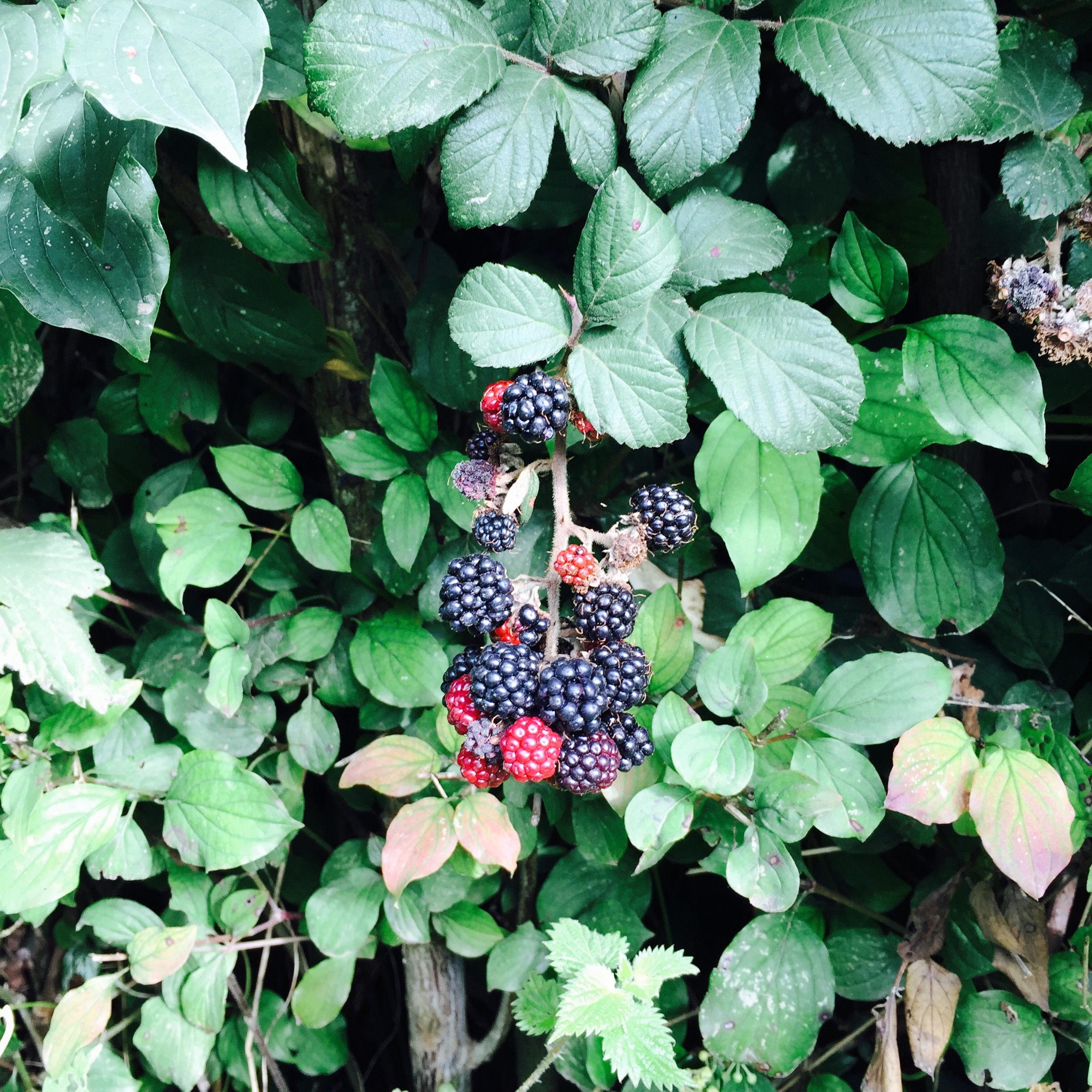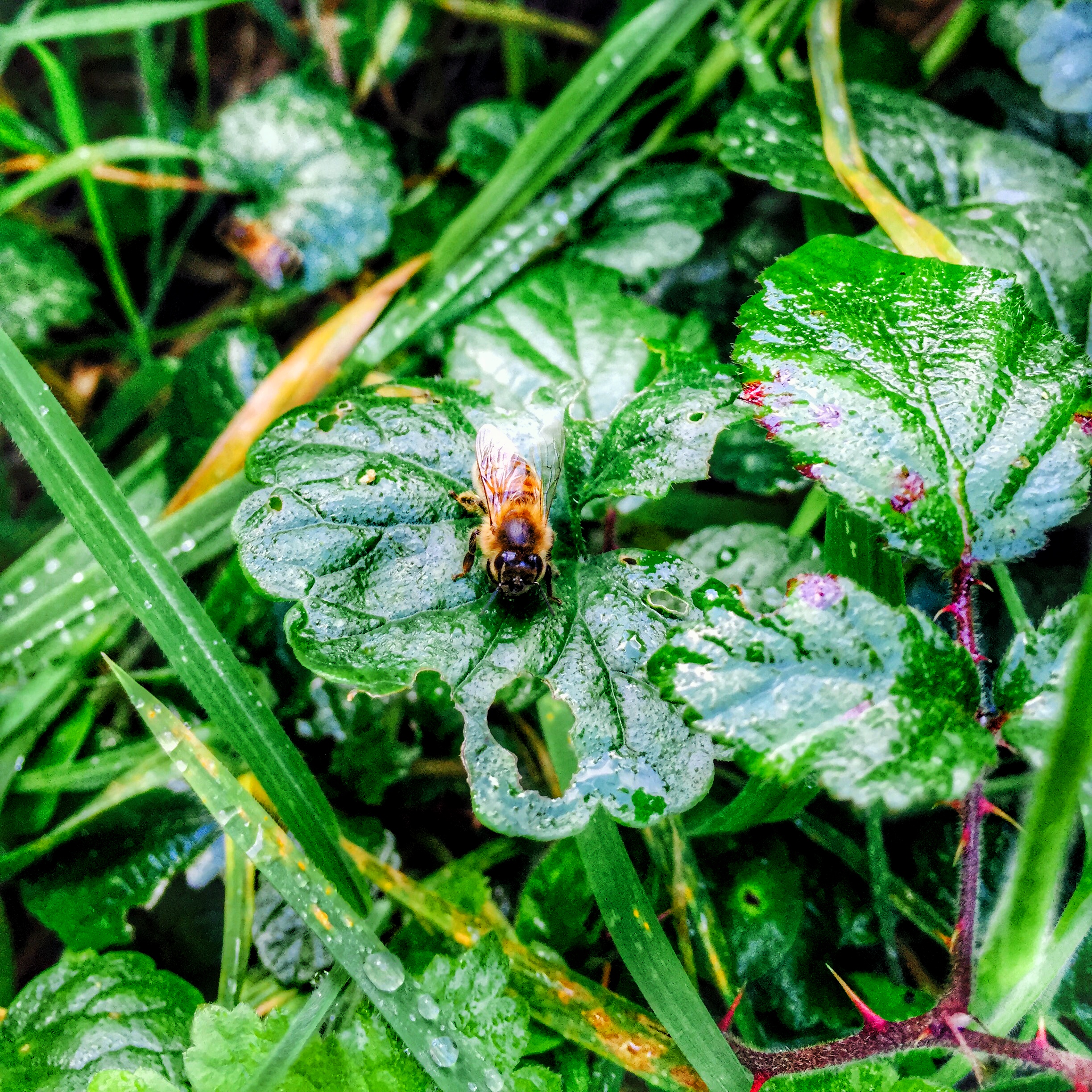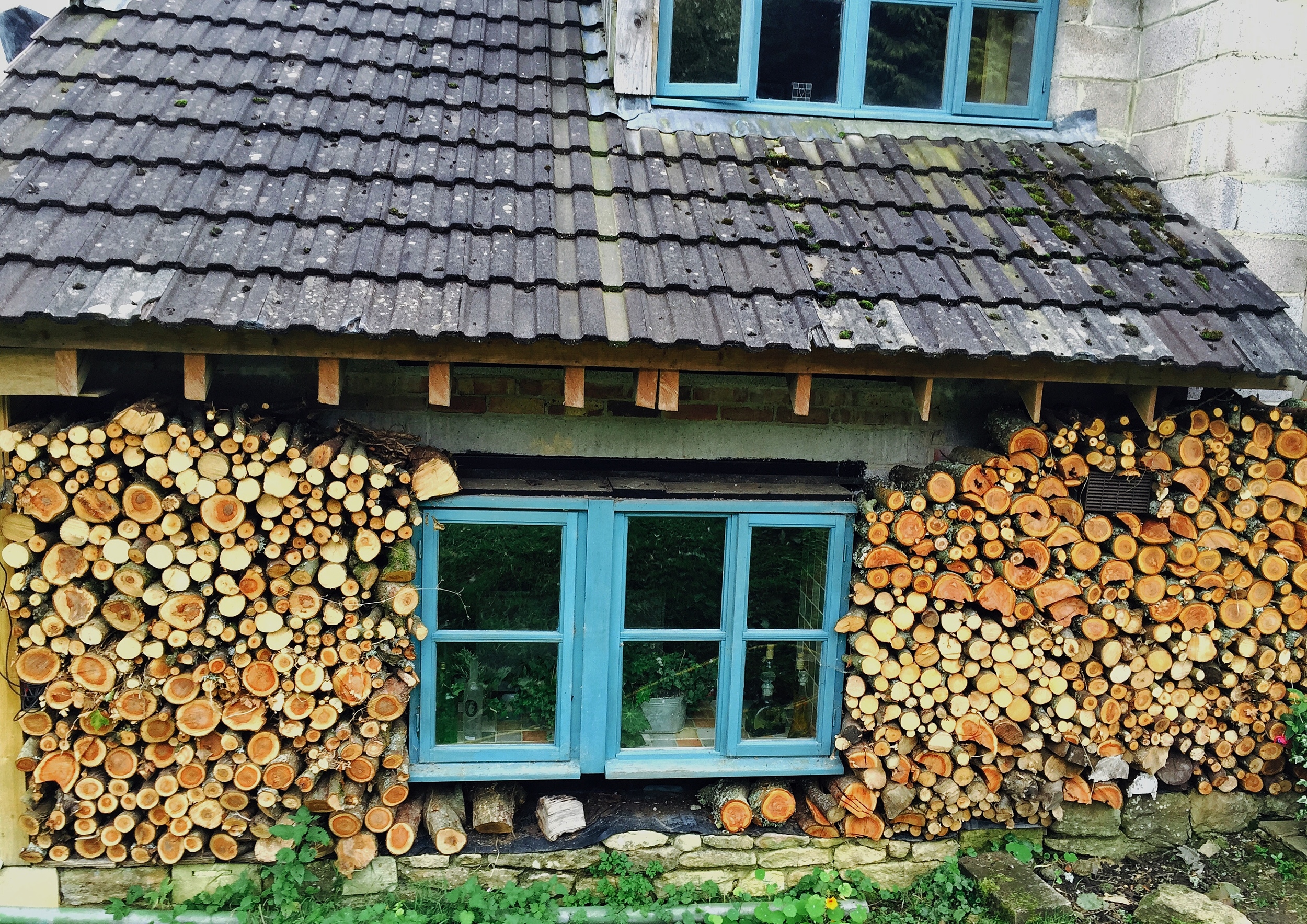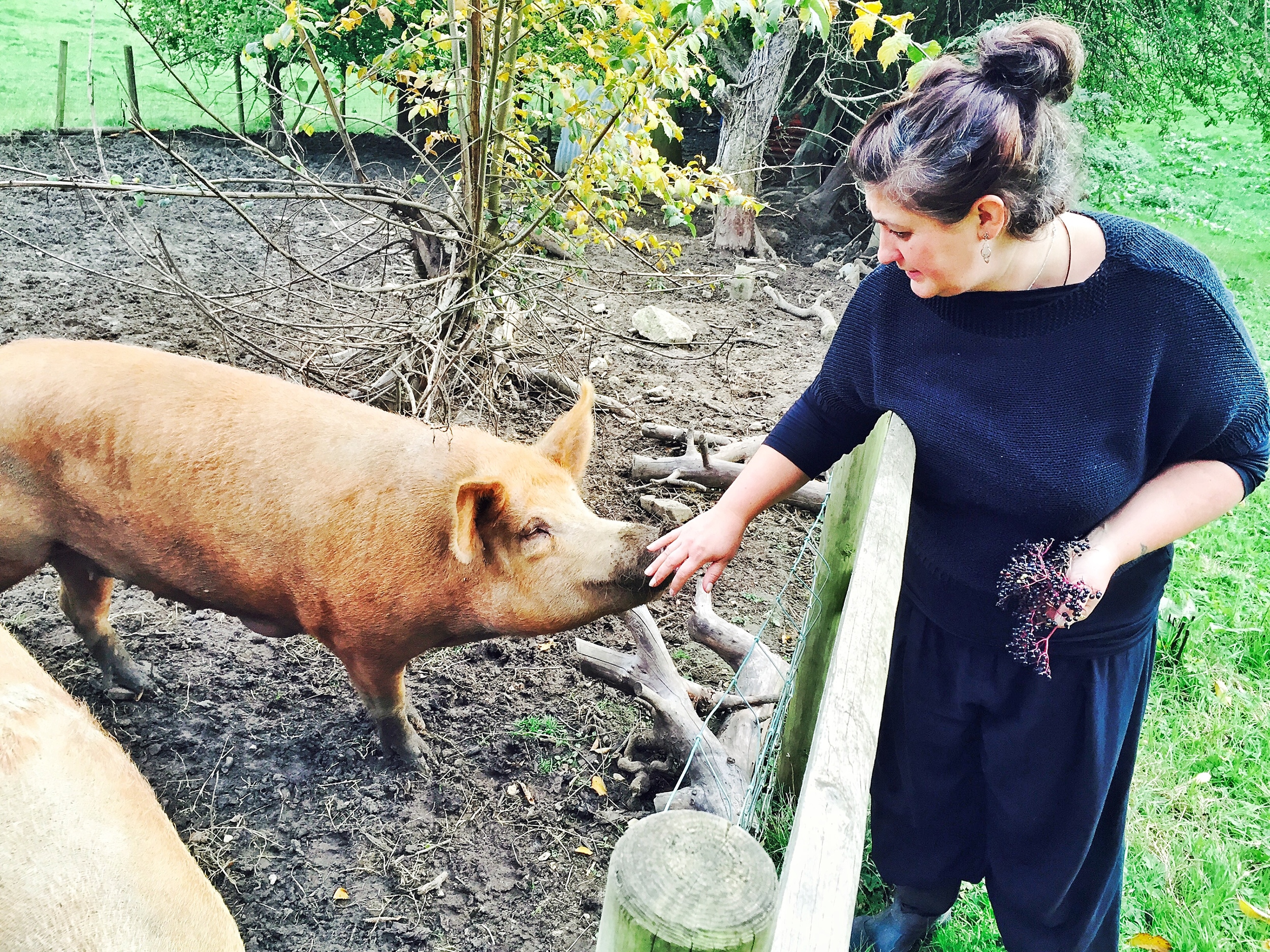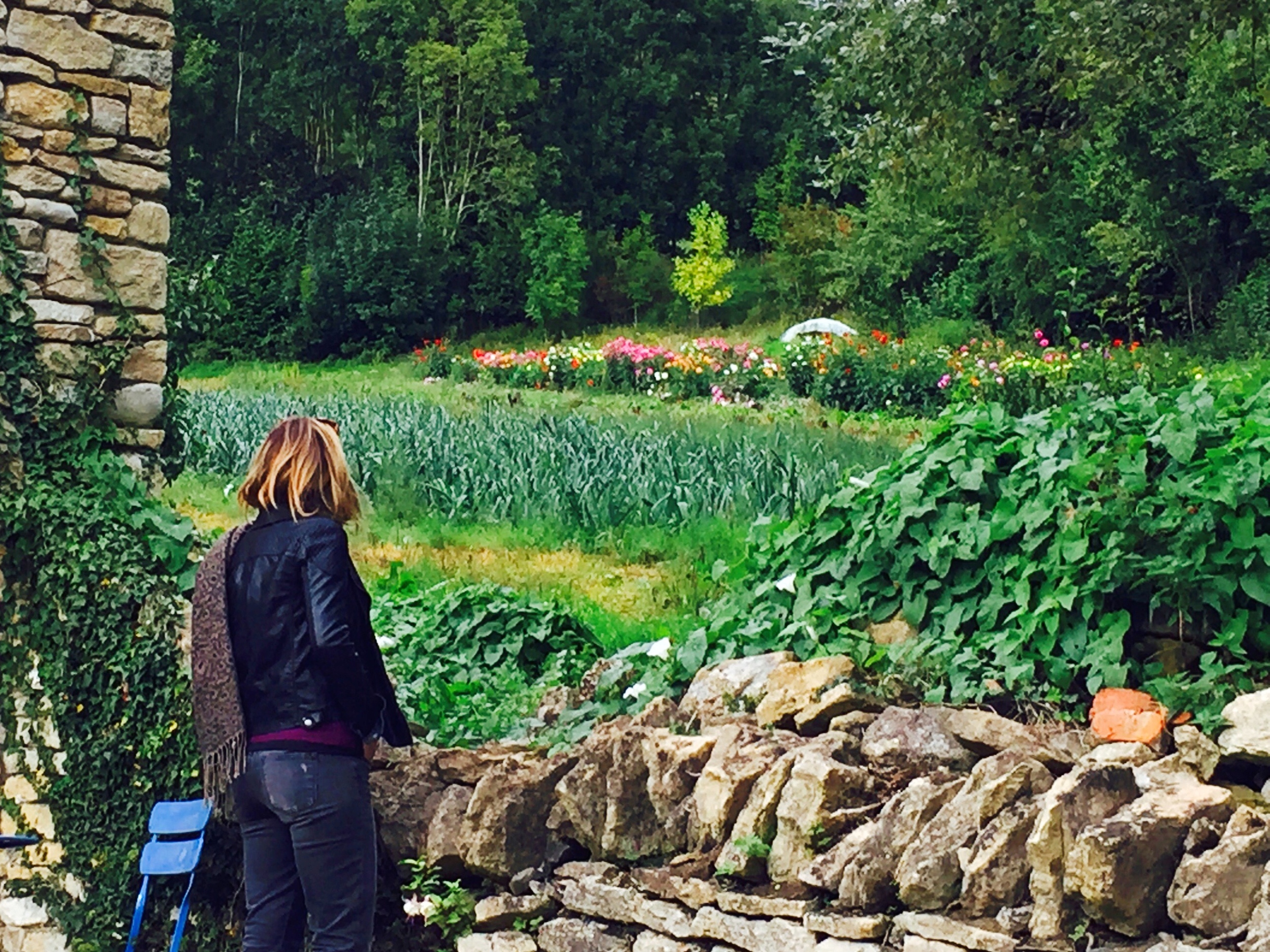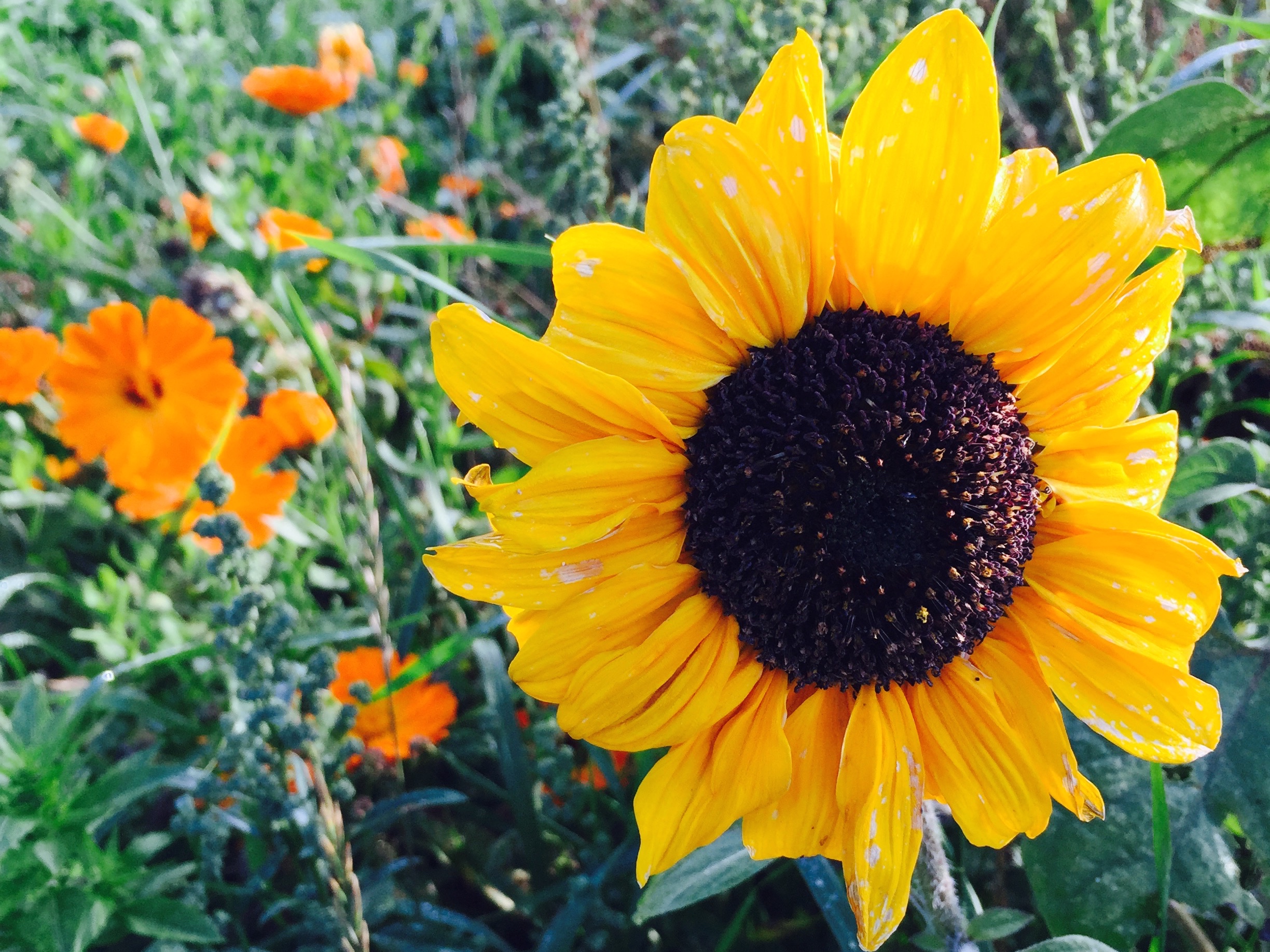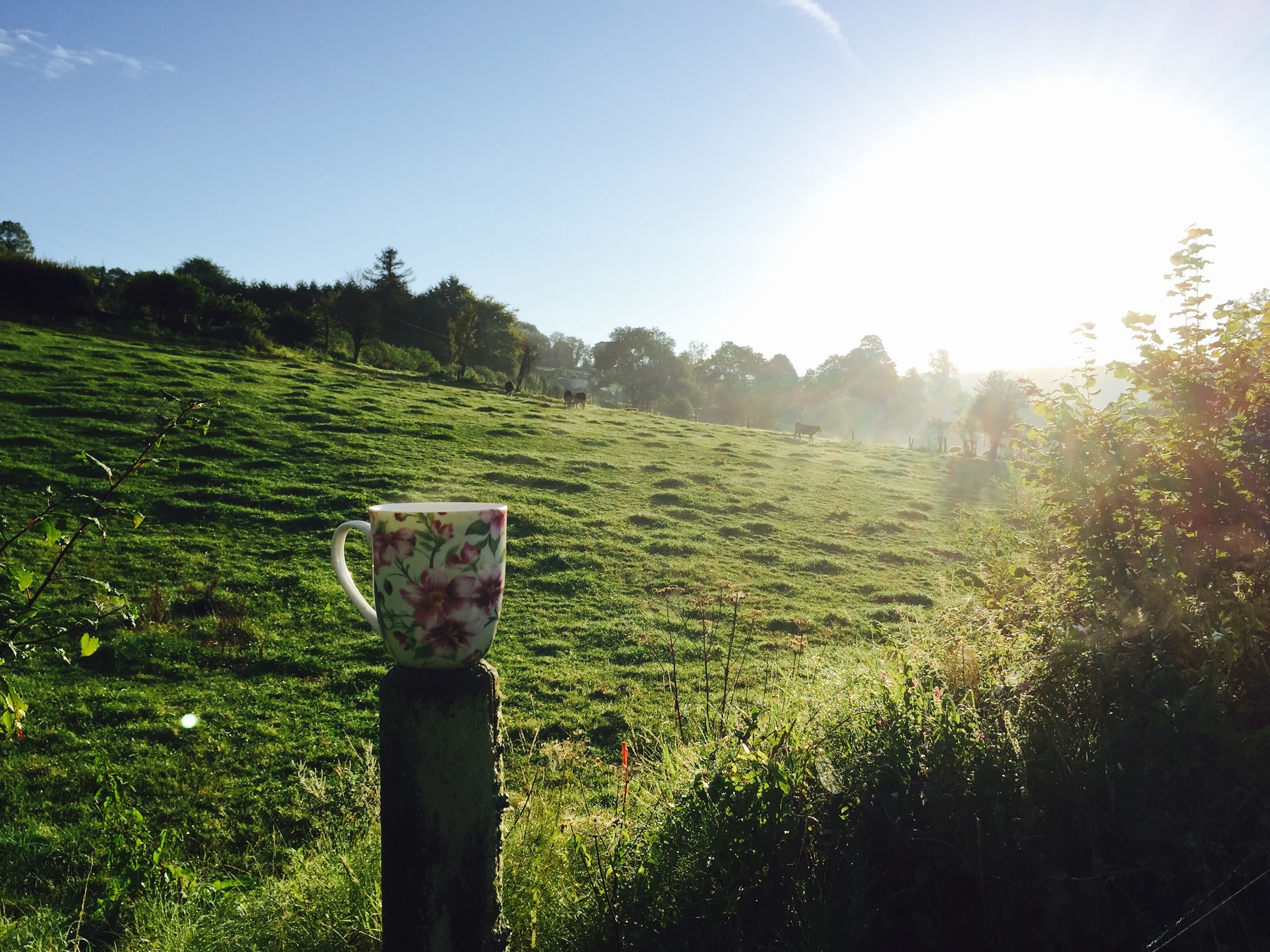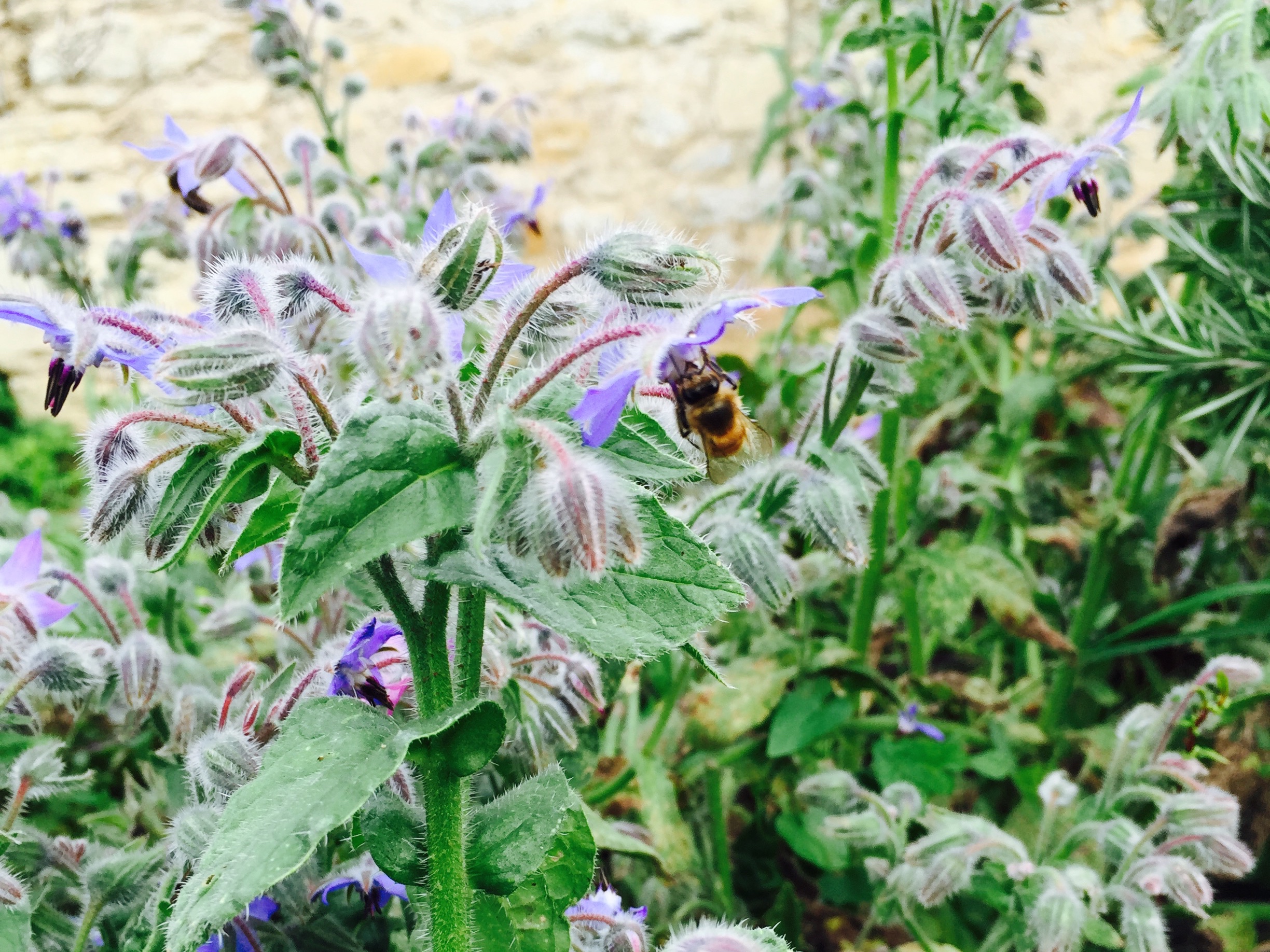For the Love of a Tree
I remember when I first read the Holy Thorn tree had been cut down in an act of vandalism. I cried out and burst into tears. I was at my parents home and was crying too inconsolably to tell them what was wrong. I was acting like someone had died. In many ways, someone had.
I remember when I first read the Holy Thorn tree had been cut down in an act of vandalism. I cried out and burst into tears. I was at my parents home and was crying too inconsolably to tell them what was wrong. I was acting like someone had died. In many ways, someone had.
We can wax poetic about how we’re all interconnected, but the true sense of kinship and belonging to this Earth happens in relationships. A relationship to one beach, one particular herb, one particular tree. Relationships that go beyond imagining the tree has a spirit, to the simple feeling of “this tree is my friend.”
I get so overwhelmed with existential grief around what’s happening to our planet, but there’s no healing when it’s that far out of our scope of relating. When the grief is for one place, one being, one spirit or group of spirits lost, then there is movement, catharsis, and possibly resonant change. When we feel feel the grief of lost relationships, we begin to understand just how tied we are to the more-than-human world. Sometimes we learn of our belonging through our loss.
I have made pilgrimages to Wearyall hill and the Glastonbury Thorn since I was 17. I knew this tree well. I have given it many offering, tied many wishes to its protective ring. The Holy Thorn was a wishing tree, a blessing tree. Across Celtic nations, there is an old tradition of tying cloth to sacred trees, both standing alone, or near sacred wells. The cloths are often wishes or prayers for healing, health, or good fortune. This tree, in particular, was connected to a local legend that claims Joseph of Arimathea visited this sacred hill, while carrying the Holy Grail into hiding. For some, this is the Grail of King Arthur’s legends, and they say the Once and Future king himself is buried in the local Abbey grounds. They also say this is where the mists parted and the priestess isle of Avalon was revealed in Arthur’s final journey beyond the veil.
The Grail Joseph of Arimathea was said to carry, is also though to have been Mary Magdelene herself, as well as the children she bore with Jesus, as the grail is considered symbolic of the Magdelene line and essence. There is even a telling that Joseph of Arimathea brought a 12 year old Jesus to Glastonbury during one of his trade missions. The tree represents Joseph’s staff, which he planted upon arrival to Wearyall hill.
This land is full of myth and legend. What I share only scratches the surface of the confluence of myths living in the landscape.
This tree too on a deeply symbolic meaning to me, but it was also a tree I came to know as friend over the years.
It was both a symbol of the greater mysteries of the sacred, as well as a point of reference. A place where I could tangibly feel the meeting of the worlds: nature and human, magical and mundane, this world and the otherworld. It was a place both solid and liminal at the same time. Many prayers of mine were given to that tree. Many have been answered.
I think in our quest to reunite with ourselves as relational members of the more-than-human world, we have to remember that it starts with individual relationships. It starts with love affairs. These can be near and far. A moment with a sea turtle in an underwater queendom. A conversation with a rock in a desert. A friendly swell of the heart when seeing a favorite creek spot. A deep sigh when gazing on a familiar mountain. Who have you befriended in this wide, wonderful earth? Which cave, tree, cactus, or meadow calls you kin? Calls you home to your own belonging?
The 3 first photos are of the intact tree in 2013. The last is 2015, after it was killed.
Dismantling the Inner Patriarch
I couldn’t bring myself to write a Friday post ON Friday because I was in the middle of my own maelstrom of self-doubt. On Friday I flew to LA for the most incredible opportunity to speak at the Natural Beekeeping Conference.
I couldn’t bring myself to write a Friday post ON Friday because I was in the middle of my own maelstrom of self-doubt. On Friday I flew to LA for the most incredible opportunity to speak at the Natural Beekeeping Conference put on by @Honeylove.
I had been invited to speak on the topics I often write about: why we keep bees and my experiences with bee shamanism. While I love these subjects, I am not used to talking about them at a conference in front of people with complex presentations on innovation, science, methodology and technique. ⠀
As the weekend went on I gathered so much applicable, fascinating information. I took copious notes. I listened to captivating conversations. But I also, quietly railed against my own nature, questioned my professional value, and felt exquisitely sensitive to the fact that my presentation was NOT about how to keep/save/study bees. It was about restoring our relationship with bees. I spoke a lot about love, mystery, and the liminal. ⠀
I wasn’t due to speak until the end, so I had all this time to question everything I stand for. To feel small as a woman. To feel like my work didn’t have value without quantifiable, tangible, physical proof. I fell for the top down model of valuing intellect over intuition. Patriarchy got me good. I was submerged in the quagmire of what happens when we let a world view tell us that one aspect of our humanity is more relevant than the other. It was fascinating.⠀
I basically gave a talk in support of all that was being suppressed by my own interior judge. It felt great. Well, the judging felt like shit, but the talk felt great. So did the camaraderie, reception from those who attended, and the commingling over the weekend, of so many devoted folks. I am so fortunate to be in a field that is starting to value the feminine/intuitive/somatic experience alongside our more “traditional” values.⠀
What could be possible for this Earth if we married the exquisite intellect with the intelligence of the body and intuition? Maybe we should ask the bees.
Lavender: Giddy Calm
I will never forget the way it hit me. Like a physical bath of scent. We arrived in Sainte-Croix-à-Lauze just as dusk descended. The crickets were declaring the glories of summer, while fireflies emerged to secret the sun away into the night. It was heaven. I got high.
Lavender⠀
Lavande • Lavendre• Lavandula⠀
⠀
Pollinators: ⠀
Honey bee, bumble bee, digger bee, carpenter bee, leafcutter bee⠀
⠀
Medicinal parts used: ⠀
Flowers⠀
⠀
Preparations:⠀
Teas, tinctures, essential oil, spice for cooking/baking, hydrosols, lotions and ointments, ⠀
I will never forget the way it hit me. Like a physical bath of scent. We arrived in Sainte-Croix-à-Lauze just as dusk descended. The crickets were declaring the glories of summer, while fireflies emerged to secret the sun away into the night. It was heaven. I got high. Quite literally, the scent of lavender so engulfed me, that I sort of lost it for a bit. I was a mess of giggles and wonder. A friend and I have meandered our way through Provence to the tiniest town in the Hautes-Alpes. There wasn’t even a cafe. It was just an old, stoney town with one central spring, and on all sides, Lavender. Fields and fields and fields of the heaviest, sweetest scent I had ever experienced.
My mother grows lavender. Heaps of it. It lines the apiary and turns dry and grey-violet each summer. It’s absolutely lovely. I cut bunches of it for making oils, sachets and wall hangings. This was NOT that lavender. This was otherworldly. I thought I knew lavender. This was something else. This gave me superpowers. This was a soup of scent. This was the the loosening of my hair. This was barefoot crush. This was an intravenous anti-anxiety drip, except with breath. Imagine breathing a sort of liquid, giddy calm. How can you be giddy and calm? Go to Provence in July in the evening.
Our AirBnB host was a tall, linen-wearing woman with a long sliver braid looped over her shoulder. She was celebrating a birthday in the neighbor’s yard with a weaver and a beekeeper when we arrived. They invited me down because, well…beekeeper. By the next morning my doorstep was filled with Oak honey and homemade rosewater. I knew, in that moment that I was about to fall in love. Not with the beekeeper, but someone. (I did by the way, shortly after, although it swiftly ended in heartbreak). I still eat a bit of that Oak honey every day. I still believe it will lead me to love.
I had just finished teaching Apis Sophia Exstasis, a women’s retreat in Aquitaine, and I was exhausted. My friend Nani and I drove 10 hours across France to hide away in a stone cottage and inhale lavender. She made me salmon that first night, but the kitchen was lacking basics and the nearest grocery story was a hour away. We made do with butter, salmon and red wine. It turns our a red wine butter sauce of salmon is quite tasty, and to this day, whenever either of us is in a bit of a conundrum we tell each other to just “Pour some red wine on it.” Can’t figure out how to keep your houseplant alive? Pour some red wine on it. Feeling confused about some nasty paperwork? Pour some red wine on it. You get the gist.
On our last night, we shared a glass (we are big lightweights, so one was clearly enough) and went for a midnight stroll through lavender fields, picking a stalk here and a stalk there, absolutely certain all wrath and furry were about to descend on us for our shitty tourist trespassing. Then we did the unthinkable (and by unthinkable, I mean I literally didn’t even think about it - whoops), and brought those stalks home in our suitcases. I know, we are the worst. No that lavender is infused into an oil that I use on my skin daily for nourishment and anxiety relief.
Used by Egyptians in the mummification process and cultivated for its oil in ancient Arabia, lavender has been a sacred and beloved herb in healing, cosmetic and culinary arts for millennia.⠀
⠀
It is an herb used for calming the nervous system, treating wounds, easing headaches, improve sleep and offers a general feeling of wellbeing.⠀
⠀
It was spikenard, a form of lavender, that Mary Magdalene used to anoint Jesus’ feet. ⠀
Lavender honey is very light, herbaceous, floral and pairs well with soft cheeses, figs, and my favorite: biscuits and Devonshire cream.
⠀
Here are some of my favorite ways to love lavender:⠀
⠀
* I use drops of lavender essential oil in my humidifier at night. ⠀
* I gather it every midsummer for making lavender infused oils (not EO). Oiling the skin is of a daily ritual for me, as I have every sensitive skin and live in a dry place. Lavender oil soothes mind and body.⠀
* I make lavender infused chocolate truffles which I used to take to Burning Man to feed all my friends.⠀
* I put it in sachets for dreams when I am needing lightness⠀
* I sprinkle it into almond honey cakes, which make great ritual offerings.⠀
* I hang a bundle over my bed ⠀
* As a hydrosol, it never leaves my side⠀
* I mix it in a calming tea blend, often with nettles, chamomile, and rose. ⠀
* I watch the bees dance through it.
Let the Bees Lead You
I know it’s called “beekeeping friday” and I ought to talk about beekeeping, but the thing is, nothing with bees is linear. This photo is all about beekeeping. It’s also about finding your voice, trusting the path, sisterhood, and magic. It’s also about hard work, discipline, punches to the ego, and realness. ⠀
I know it’s called “beekeeping friday” and I ought to talk about beekeeping, but the thing is, nothing with bees is linear. This photo is all about beekeeping. It’s also about finding your voice, trusting the path, sisterhood, and magic. It’s also about hard work, discipline, punches to the ego, and realness. ⠀
⠀
This photo is from yesterday in France, after finishing the evening’s work with my bee sister and trusted colleague, Gina. It’s taken a lot of trust and surrender to get here. We didn’t know this was coming when we stepped onto the lemniscatic path. I didn’t know work could look like this. So here we are: this is our debrief after after a hard day’s work. This is also a moment in my actual life where bees brought me to the south of France to teach bee shamanism in an open air barn with this view. ⠀
⠀
What I’m saying is, I fell in love with bees. I fell in love with the mystery behind their ways and the history woven into women’s relationship to the hive. I started beekeeping, in part to save my heart (and life) after miscarriage. I have followed the strange and crooked path of listening to the wild one within and the wild ones without. That path has landed me in the gracious arms of a growing hive of bee women who are courageously facing their own tangled fears in order to become voices for the earth and the feminine once more. To claim sovereignty, eros, seership and the full expression of self.⠀
⠀
So this is about beekeeping, because beekeeping is about listening to the bees, and in my book, listening to the bees goes far beyond the realm of “normal” and sails straight into the land of mythic reality. The bees fly on crooked paths through liminal thresholds, and when we let them, they show us how to do the same.
Shamanism Meets Tea Time
I’m about to board another flight to London. I seriously can not wait for scones and tea at No. 9 on the Green in Wimborne. I am visualizing pouring cream into a saucer as I write. Heaven.
I’m about to board another flight to London. I seriously can not wait for scones and tea at No. 9 on the Green in Wimborne. I am visualizing pouring cream into a saucer as I write. Heaven.
I have a suitcase filled with long skirts, a wooden distaff, special rocks, wellies, and an air purifier. Not the most obvious choices for a trip to England. Ok, the wellies get a pass, but they’re so damn heavy and awkward. (Please don’t tell me to wear my weight on the plane. You ever try wearing knee high rubber boots 7 miles over the ocean?) I’m on my way to the Sacred Trust, a school for shamanism, deeply rooted in the Path of Pollen, a European shamanic tradition with the honey bee at its heart. The air purifier is just because I’m allergic to mold. Go figure.
People have started to ask me if I live part time in Europe. I’d LOVE to say Yes, but the answer is, not yet. Since 2010 I have been traveling to the Sacred Trust to study a form of shamanism that survived the Romans, the Dark Ages, and the Inquisition. I equate it to a graduate program. A big investment with my time and money, which is helping improve my mind, body, heart, career and life path. That’s how I justify it to my left brain. My right brain couldn’t give two effs, because this work is 600% soul food.
The school teaches a line of gynocentric, bee-centric shamanism that honors the feminine principal. It is mostly made up of female students, although there are many men starting to take newly offered classes for all genders. It mostly works with bees, but there are serpents, stags and spiders woven in. It is multidimensional and embraces the betwixt and between.
The tradition is a small golden thread. A quiet hum that lasted through the burning of our grandmother’s grandmothers. It’s an answer to my American hunger for spiritual belonging. A hunger that longs for a sense of spiritual roots, but wars with how to be a native Californian without appropriating the spiritual traditions of the Indigenous people of this land. I can not begin to describe the relief I felt when my heart encountered the bee tradition and I cried those soul-aching tears of recognition, knowing that somehow, not all had been lost.
Let’s unpack that for a moment. First and foremost, I need to address privilege. I’m a white, western woman. My ancestors are oppressors and I carry that in my lineage. I refuse to be blind to my own privilege, and as a result of that refusal, I keep discovering ways that I have been. Let me just state that I am learning and I have a long way to go. Also, I fly over an ocean 1-3 times a year in the pursuit of earth-based wisdom connected to the part of my ancestry that was oppressed by Patriarchy and Christianity. So while I resist the dominant social institutions of the former two powerhouses, I am also partaking in the hypocrisy of the entire capitalist, planet-degrading #deathspiral, by using fossil fuels to catapult me in a metal box to a place where I can feel connected to the earth. That’s some real bullshit right there.
Yet, I also subscribe to the idea that there are certain soul places on this earth. Certain spots that speaks to us. Speak through us. Calls us. Awakens us. Claim us. Can a person be OF their native soil and also OF a patch of earth 6,000 miles from where they first touched their feet to the dirt? I most certainly have been claimed by more than one place in my life. Just are sure as I have been claimed by more than one heart. The English countryside is one of those places. And it requires a good set of wellies.
On with further unpacking. When I say I cried because “not all had been lost”, I mean, I am woman and a member of the gender(s) who were and continue to be shamed, maligned, violated and abused for our sex/identity. The wisdom ways of women and the honoring of the feminine in earth-based traditions were nearly snuffed out in Europe’s long history of violence against the life-bearers. Coming to a tradition rooted in my ancestor’s homeland that honors the voice of the womb and the power of the feminine principal is cathartic, to say the least. We ascribe voices to various body parts all the time, but when was the last time you considered the womb to have a voice? Not just the heart, or the head or the phallus, but the womb? Think about it.
Now imagine if you found a place tucked between meadow and forest where you were encouraged speak with that voice. Dance with that voice. See with those eyes. Utter with that yonic intelligence. Imagine relearning your body as though it were flowing with nektars, like a flower. Imagine learning new tongues informed by wind, sea, honey and fire. For those of you who have been wondering why my feed is periodically filled with photos of tea and cobblestones, that is why.
What is The Path of Pollen? I can’t really answer that. It is indefinitely ancient and ever new. It’s part of a very old story. It’s part of writing a new story. Its fingers are made of threads, its head made of stars, its womb made of bees, its longing made of serpents entwined. It is wombic. It is phallic. It is Both And. It is Neither Nor.
I am part of a tradition that stretches its storylines back through the distaff path of ancient Europe. It is a tradition of bee women, known as Melissae, and is very much alive and well in the modern world. The Melissae were the bee priestesses of ancient Greece, most commonly connected to the oracular Temple of Delphi. The Delphic Oracle, also called the Delphic Bee or Pythia (pythoness), was the prophetess for the Earth and of the Earth. It is said the priestesses inhaled the breath of the Dragoness, Python, Gaia’s daughter, and entered a trance, uttering prophecy for all who came to the temple.
I am here to remember how to listen to the voice of the earth, as she arises, a buzz, from within. Ten thousand bees offering nectar on the breath of python. May I be so lucky to glimpse her in the mirror.
And I’m here for tea, scones and whisky, because I’m multidimensional AF.
Stalking the Wild Feminine
It’s going to be hot out there. No-option-but-naked kind of hot. Snake weather.
The bees will be gathering water from the banks of the Eel. The water ouzel will be dancing her grey-winged hop up and down the river. The bears wont come near. There are too many of us.
It’s going to be hot out there. No-option-but-naked kind of hot. Snake weather.
The bees will be gathering water from the banks of the Eel. The water ouzel will be dancing her grey-winged hop up and down the river. The bears wont come near. There are too many of us.
Tomorrow I’m going backpacking with thirteen dear friends. A reunion in the California wilderness. Ten years ago, we piled our bright eyes and burgeoning adulthood into a few likely-to-fail vehicles and set out on a four and a half month journey into the wilderness. I wouldn’t exactly call is a backpacking trip; it was less hike-through and more wilderness emersion. Alumni and friends of the Sierra Institute program, we went to learn about ourselves from the wilds and each other.
Three weeks fishing in the Marble Mountains, two weeks tucked under dripping canyon alcoves on the Dirty Devil river, three weeks following the creek lines through the frosty Whites, five days with grandmothers and ceremony in the Sonoran desert, twelve days vision fasting on the Kaibab Plateau with the School of Lost Boarders, a week along the sea battered edges of the Sinkyone. We sat in council, we ate wild watercress and wood sorrel, someone got lost for three days, people shared backcountry romance, people got sick, people got fed up and left, we disagreed, we laughed, we read stories aloud, wrote songs, met bears, wiggled into backcountry skin, made amends with our nature-starved souls, and broke ourselves against modern society.
We’re going back now. Thirteen busy adults with busy lives, affording ourselves four days to pay homage to four months of life altering earth-speak. For me this means snakes. Rattlesnakes. I find it a terrible irony that my favorite place in the wilderness is also one of the most snakey out there. To further the cosmic joke, I was born for wild places, yet life offered me a highly traumatic early childhood experience with death and a rattlesnake. Fast forward through twenty years of snake nightmares and debilitating phobia, and you find me dawning a heavy pack, hyperventilating in an Arizona parking lot, and hoofing it into the snake-rich springtime desert. I would not be defeated by phobia. I would stalk the wild feminine and surely and she stalks me.
Now, I am versed in venom. A woman of the bee, stung time and again. Since that journey, when I came face to face with my nightmare pursuer, I have negotiated a new relationship with bite and sting. I am not less afraid, but I less crippled. I am more whole. It has something to do with learning the language of dreams. With learning to read the story differently. Why does the serpent bite me, pursue me, threaten my sleep? Could it be the old magic, the earth magic, seeking a way in?
The Bees became my bridge to the Snake. In their hidden way, they revealed the old stories about the sacred serpent. She who moves through the earth. She who is pure creative power. Pure sexual life force. The embodiment of the divine feminine. In ancient Greece, the Oracle of Delphi, she who famously uttered prophecy, was known by two names: the Delphic Bee and the Pythia. She was a Melissae, a bee priestess, but she was also of the serpent, the earth-dragon. Pythia is a Greek name derived from Pytho, the old name for Delphi and our root for the snake species, Python. Pytho or Delphi was the center of Gaian mother culture; the navel of the world. This center point was represented by a stone, the omphalos, an egg-shaped carving guarded by Python and used in the uttering of prophecy.
John Collier [Public domain], via Wikimedia Commons
As Patriarchy made it’s way into Greek culture, the Pythoness became a monster. Apollo, the sun god, slew the serpent and Pytho became the Temple of Apollo. The divine feminine force was overthrown, shamed, violated and erased. So, we have another story of how we split ourselves from the natural world. How we took the wholeness of human expression and divided it, driving the stake down through our own sense of who and what we are. Divorcing man from nature. Woman from man. Sexuality from the sacred. The female form, she who knows the language of the serpentine flow, is exiled from the holy. Exiled to the point that today, in American politics around health care, simply being a woman is considered a pre-existing condition.
It is no wonder that I have been stalked through my dreams by the snake. From a shamanic view, to be bit by an animals in dreams, often signifies taking on the animal's specific powers or medicine. It is an invitation, never mind how terrifying. When we dig in to the storied myth-lines of our dreams, when we look at them as more than simply the psychological detritus of our day, we find breadcrumbs towards a fuller expression of self. We find that the antidote is venom, and the poison is our own disconnect between self and nature.
I talk to my bees. I ask them to teach me. I dream with them. I dream of them. They show me through sting, nectar, pollen and hum how to be a more embodied woman. Let's call it earth magic. Tomorrow I will set out on the trail, and have my conversation with the snakes: “You’re beautiful. I love you. I love the way you move. I will not harm you. I am afraid of you. If you choose to show yourself to me, let it be gentle. I love you.” Who knows if it does any good, but it places me firmly in my body, and I begin to weave my way back into Wilderness Self. Perhaps our wild feminine needs to be approached as such, aware of the long exile and the fear that comes from not knowing how to be around a force of nature that is so powerful. Even when that force is expressed through our very form.
You’re beautiful. I love you. I love the way you move. I will not harm you. So mote it be.
Silver Spring
England is full of natural springs. Every time I come here, I seek them out. There is nothing like drinking pure water, straight from the depths of hte earth. Almost all of the springs and wells in England are dedicated in one for or another to the sacred.
England is full of natural springs. Every time I come here, I seek them out. There is nothing like drinking pure water, straight from the depths of the earth. Almost all of the springs and wells in England are dedicated in one for or another to the sacred. As if often the case, most sacred springs were regarded as such by pre-Christian peoples who lived closer to the land and revered the spirit of place. Locations like mountain peaks, caves or a fresh water springs all had associations with a particular spirit, or the Great Mother goddess of the land herself. Over time many of these spirits became associated with specific Celtic gods and goddesses such as Sul, goddess of the thermal springs in Bath, or Brigid, goddess of healing, music, poetry and smith-craft. As Christianity moved across the land, most of these sites were appropriated by the Church, renaming the springs after the Virgin Mary or Christian Saints.
In Cerne Abbas, Dorset, there is a beautiful spring known as the Silver Spring, or officially as St. Augustine’s Well. It is located in a small tucked-away corner of the Cerne Abbas Abbey, and is shaded by over-hanging trees. On the hill beyond the well there is The Giant of Cerne Abbas: a huge image of a man with a giant phallus carved out of the chalk hillside. He is the main tourist attraction for Cerne, and the villagers regard him with both playful and serious respect. The Silver Well acts as the energetic balance point of the feminine, offering quietude, healing and solace to those who visit.
The bench next to the well has the words "Whoever Believes in Me" carved along it's side. Prayer tree/bush is just behind bench.
The spring’s most current patron saint was established by monks from the abbey in the 11th century. St. Augustine of Canterbury (d. 604 AD), said to be responsible for converting England to Christianity, supposedly struck the ground with his staff, thus producing water. No patriarchal symbolism there, eh?
On a plaque in the abbey grounds, another legend suggests St. Edwold came to the spring after dreaming of a silver well. While out walking the land, he happened upon a shepherd. He gave the shepherd silver coins in exchange for bread and water. In return, the shepherd showed St. Edwold the spring, which he recognized as the spring from his vision.
The Silver Spring in mid-winter flow, 2014. The water bubbles up from the back of the deeper pool.
The Silver well was associated with the feminine long before legends of patron saints and continues to hold folkloric traditions. This is made clear by the spring’s association with fertility and love. Women who wish to become pregnant drink from the well to cure infertility. Young women looking to find a husband used to the well as an oracular site or drank from the well while praying to St. Catherine.
Above the well, a rose bush stretches toward the water. Tied to it’s branches, are colorful ribbons and small rolled-up pieces of paper with prayers written inside. This is not an uncommon sight at holy springs in Britain. You find a similar tree on Wearyall hill and another over the Chalice Well, both in Glastonbury, Somerset. For me, these prayer trees symbolize a harmonious way humans interact with the sacred landscape, without needing to build a church on top of it to mark it as holy. I love the multi-colored prayers, ribbons fading in vibrancy as sun and weather do their part. A small exchange between human and spirit of place, an offering perhaps, a wish.
Prayers on the rose bush next to the Silver Spring, Cerne Abbas, Dorset.
To this I offer my own: a prayer for the water to return to California. I live in Northern California. Beautiful, wild, river and pine California, which is currently suffering from a horrendous drought. The week I left for Europe, two massive fires broke out, consuming vast amounts of land, homes and our beloved Harbin Hot Springs. Ultimately, my prayer is for people to initiate change. A change in our commercial agriculture system, that so bleeds the land of her water, draining California’s central valley aquifer and demanding a kind of production from the land that is unsustainable, to put it kindly. May we each do our part to find new and old ways to nurture our relationship to food, pollination and consumption.
The thorn tree on Wearyall Hill, Glastonbury, England.
Holy thorn before it was vandalized, 2010.
Maggie Daly in Connemara, Ireland, 2009.
Beautiful Homes for Ladies and Bees
Sometimes it's important to take a moment to simply appreciate beauty. Physical beauty. Beauty of nature. Beauty of place. Beauty of soul. I've been thinking a lot about beauty lately. Beauty as a power that evokes a sense of peace, wonder and love.
Sometimes it's important to take a moment to simply appreciate beauty. Physical beauty. Beauty of nature. Beauty of place. Beauty of soul. I've been thinking a lot about beauty lately. Beauty as a power that evokes a sense of peace, wonder and love. Beauty that comes from the natural world and is emulated time and again by art. Whenever I travel to places that have architecture older than the birth of my country, I am wistfully awed by the detail and artistry found in everything "old". The artistry found in homes, gardens, cathedrals, temples and pieces of furniture.
Beauty moves us. It inspires us. It is a powerful agent of spirit, and we are drawn to it in it's exterior and interior forms. This post is a nod to the human capacity to create art and beauty through the form of a home and a hive.




















These photographs are of a home I had the luxury to visit after completing my workshop in Bath. I spent a glorious afternoon and evening, surrounded by many bee sisters, soaking up the beauty of place, kinship, healthy food and deep rest. I am aware of the privilege of this experience, or the privilege to travel the world for please in the first place. I am aware of how many people are in incredible suffering while I write a post about a beautiful home. I often come up again this conundrum when appreciating beauty that comes from affluence. How can we appreciate or have privilege and luxury while remaining in service to creating a world with greater equality and less consumption? I don't have an easy answer, other to be fully present with where I am, feast or famine. If I am offered a room with a mural, a dip in a private pool and the most generous of meals by a kind sister, I will be in gratitude, I will ask myself to relax, I will be in my heart.
There is no better teacher for this kind of presence than nature. She, the Earth, the natural world, has a beauty, a wildness, that has captured the mind and imagination of artists and biologists alike. The incredible perfection of life-sustaining forces that create mathematically complex growth and movement patterns such as the spiral of a sunflower's seeds, the orbits of the planets or the hex of the honeycomb. Across many ancient and indigenous cultures, this interior world of the hive is one of the most highly regarded examples of nature's mysterious, divine beauty. Glyphs and art depicting the human reverence for the honey bee are found as far back as ancient Egypt and Sumer.
Have you ever seen the inside of a hive? Watched the bees move across comb? Been mesmerized by the coming and going of pollen-bearing, sun-glowing insects. And have you ever notices how this incredible beauty is so disregarded by the form and mechanized construct of the conventional bee hive. Langstroth hives, the white boxes you see lining desolate orchards in drought-stricken California for stark example, were built for humans in order to maximize honey production. They have very little to do with what is most beneficial for the honey bee colony. I'm not unequivocally against Langstroth hives. There are plenty of bee-sensitive beekeepers out there who use langstroth hives. If you go to a bee supply shop, you'll find supplies for a Langstroth, but you likely wont find top bar hives, log hives, golden ratio hives or Warré hives (unless you go to Bee Thinking in Portland!). I'll get into my pro's and con's, feels and theories about lang hives another time, but for now, lets just say, I've tried them out and we didn't become best buds.
There are so many hive styles out there, ranging from log hives found in trees (see Michael Thiele's work with log hives), to sun hives, to strange walled contraptions that are supposed to offer high-rise indoor observational viewing (iffy choice). I encourage anyone interested in getting bees to look into some of the back-to-nature, DIY hive styles out there. Alternatively, you can build or buy a Warré or Kenyan Top Bar hive - two top bar style hives that are relatively well known. Note: I'm not getting into the British national hives because it's not quite as well known in the states and I don't have enough knowledge.
Combining art and hive style, more and more beekeepers are getting into beautifying the exterior of their hives, and why not? We see such incredible beauty in nature's own work, why not show the reverence of the interior temple of the hive through our artistic additions to the exterior? If you decide to put your bees in a box (as opposed to a skep or log) and become responsible for them, why not let it be a box of personal artistry? Painted, carved, designed, and placed in a beautiful space - let your creativity come through.
Perhaps through this artistic weave between the human world and the non-human we can all find moments of presence with the beauty that is Spirit in form.
An Apiary in the Hedgerows
Angharad has just returned from a walk with a handful of blackberries, elderflowers, nettle and apple. She is going to make a fruit crisp and some tea. Three things about this:
1) Angharad wildcrafts like some people (me) frequent cafes; It’s a nonchalant, every-day sort of thing.
Angharad has just returned from a walk with a handful of blackberries, elderflowers, nettle and apple. She is going to make a fruit crisp and some tea. Three things about this:
1) Angharad wildcrafts like some people (me) frequent cafes; It’s a nonchalant, every-day sort of thing.
2) She doesn’t have to do so with the fear that someone will run her off with the right to bear arms and an angry dog. Novelty.
3) She found bee hives.
An apiary to be exact. The next farm over, near some old rows of sunflowers and leeks.
But first things first. Angharad is one of my English bee sisters. I’ll be saying 'Bee Sister' from time to time, so to be clear, a bee sister is a kindred spirit, Woman of the Bee, and usually also a woman whom I have studied with in England regarding old folk traditions to do with honey bees. I am staying in a terribly adorable cottage with Angharad and two other American bee sisters while we attend a workshop in Bath.
Angharad is an artist from Devon, a woman of the moors, and a fantastic maker of “worthy” foods: a Devon slang (she says) for particularly extra healthy foods that go well beyond “crunchy granola”, into the realm of hand-ground grains and self-harvested seeds. Naturally, she found us an autumnal feast of berries. You can find her art here.
The bee yard she discovered is a colorful haphazard apiary tucked in a circle of evergreens. The boxes are in different states of age and disrepair, brightly painted and oriented outwards. Tools and comb carcasses like about, and the bees feel a bit on edge, but healthy nonetheless. This beekeeper treats the bees. There are bottles of chemical treatments on the grass. There is also a hungry, nasty nest of wasp, ever-hunting the weaker colonies. I imagine this is why the bees feel a bit on edge.
Wasp are a big problem for honey bee colonies in England. Most beekeepers I’ve spoken with are used to loosing hives from wasps the same way American beekeepers talk about varroa mites (although England has varroa as well). In the summer, many beekeepers reduced the entrance to their hive to bee size: just big enough to allow one or two bees to pass through, and allowing guard bees a smaller territory to defend. Once a wasp gains entry to a hive, it will eat brood, honey and kill bees. If it makes it out of the hive alive, it is covered with the scent of the hive and the guard bees allow it back in, not realizing it is an imposter. Entire colonies are taken down in this way. You can imagine why this apiary may have been a bit more on edge.
There is something so liberating about walking the english countryside. While I’m sure the local farmer wouldn’t exactly love us ladies visiting his/her hives, the fact that they are just simply there, up the track without a fence, a “keep out,” or a “beware of bees” sign, softens my heart. This is a country made of up footpaths and hill walking. I feel simply elated when I see another Public Footpath sign jutting out from the hedgerow. Like I’m getting away with something every time I pick an apple or strike out across of field scattering timid sheep. If you pass someone on a walk in the countryside, you always say hello. It’s neighborly and civil. I love it.
It’s the same with bees. Or any being really. It’s a kindness to say hello. To introduce yourself. I said hello to the horses, the sow and her piglets, and to the apiary (to be honest I didn’t say hello to the wasp nest). It’s more than hello however. When approaching a hive, it’s a matter of sending love and intention out with the hello. The hive is a fully conscious, highly intelligent being made up of many many functioning cells, called bees. It can feel your intentions, your mood, your fear, your anger, your love. And if you listen you can feel the nature of each hive itself.
In my case, I noticed the hive I was standing near at the end of my visit felt a little agitated. It was the hive closest to the wasp nest, so perhaps this is why. I chose to walk away, but on my way back down the track, a bee got caught in my fuzzy sweater. Once a bee is caught in your hair or your clothes, they often struggle to burrow in toward the warmth of the skin where they can sting. Think about their chief predators, bears, skunks and raccoons with thick fur. I removed the sweater, walked further away from the hives and opened it up to release her. Unfortunately, she was not happy with the experience and immediately gave me a small sting in the belly before nailing me on the wrist.
Word to the wise: if you get stung near hives and don’t have protective gear, calmly walk away from the hives so as not to draw attention with the scent of the sting.
Second bit of advice: because I'm not severely allergic, I often try to lay down and let the medicine of the venom do it's thing. You can too, although, I'm not a doctor, so always use your best judgement. It is uncanny how often bee stings end up on prominent meridians or places where you’re already experiencing aches and pain. The potent dose can be quite healing. In fact, there is an entire modality of healing dedicated to apitherapy and bee venom therapy.
However, if it’s really not your game to lay in the grass and feel the poison move through your body as a healing agent, then you can try all sorts of things to cool and draw the poison like baking soda paste, bentonite clay, honey, raw onion, arnica gel, ice and kisses.
In the meantime, I encourage walking the hills, pinching apples and wandering into secluded apiaries to feel the magic of the bee.
A Water Way
California is burning right now. When I left my home state the air quality of my town was registering at the most hazardous level it can go. Can’t even leave the house, they say. Strange then, to come to a place with so much water.
California is burning right now. When I left my home state the air quality of my town was registering at the most hazardous level it can go. Can’t even leave the house, they say. Strange then, to come to a place with so much water. The amount of green in this place has a stunning effect on the eyes and the breath. I can feel my body soften and relax in ways that it can never do in the increasingly dry climate of California.
I am staying in a farm cottage with four girlfriends just outside of Bath, England. In many ways, Bath is the heart of the waters of Britain. It the source of thermal hot springs that have been enjoyed by the Celts and made famous by the Romans. It is the only place in Britain where you can bathe in natural thermal waters. Presiding over such an important temple of cultural heritage is the ancient goddess of the land, Sulis. She who's healing power reside in the water that pours fourth from between her legs, from the womb of the earth, unto the land. This Celtic goddess came to be known as Sulis Minerva to the Romans, who built a temple complex around her springs, which you can still visit today.
I was lucky enough to join 11 women for a bathing session at Cross Bath's, the original spring dedicated to Sulis. Every trip to England includes a visit to one or more sacred springs. I find incredible peace at these ancient sites of pure water. However, bathing in springs - a hot springs - is a different matter. It's a complete and utter submersion into the feminine in all her regenerative power.
I am reminded of all the legends linking sacred springs to fertility, marriage and birth. I am reminded of all the women struggling to conceive, to maintain a pregnancy. I am hearing my sisters speak of how deeply our bodies need this water to support the gestation of a baby. I am hearing my sisters speak of drought across the lands and what can be done, what can be done? How do we bee-come the water that regenerates the earth?
I am reminded that there is still work to be done, honey bees to tend and that carving out a path for Woman to claim her place in the wheel of life can be as simple as how one approaches a bee hive. And it can be the roar from the depths of the oceanic womb that calls forth a more nourishing relationship to earth than the one our society is currently expressing. This is why we are beekeeping in skirts here. Metaphorically and/or physically. We are asking and hopefully embodying a different way. A wise, wild, watery way.
Bee Abroad
I’m 4,875 meters above England, moving at a ground speed of 463 km/h. To my left the sun is doing that peaches-on-a-bed-of-whipped-cream thing to the clouds. It’s obviously very beautiful. And I’m trying out this whole blogging thing because we can blog from the sky now. And also because of bees.
I’m 4,875 meters above England, moving at a ground speed of 463 km/h. To my left the sun is doing that peaches-on-a-bed-of-whipped-cream thing to the clouds. It’s obviously very beautiful. And I’m trying out this whole blogging thing because we can blog from the sky now. And also because of bees.
These tiny, humming, vibrating, stinging, pollinating creatures have whirled their way into my heart and left me looking at every garden, rooftop, field or urban balcony thinking, “You could totally put a hive there.” I used to do this with pianos. That sort of breath-catching elation you feel as a teen when the boy or girl you have a crush on walks by? I used to get that for grand pianos. I still kinda do. But now I have my own piano, and I’ve played grand pianos all over the world (yesterday in Oslo #parkertpiano), so now, the thing that gets me all giddy, soft and full of wonderment is the sight of a tiny insect.
Have you ever walked by a tree, or maybe a patch of lavender and been stopped short by the sound of the Hum? Try listening. Anywhere really. City or country. Just listen for the low buzz your heart would make if it had a sound and you’ll surely come across it. If you live near ivy this time of year, start there. It’s outrageously loud once you tune your ears to the buzzing of honey bees feasting. Or making love. I’m not sure which one to call it.
Right now I’m on my way to England to study with a shamanic school deeply entwined with her Ladyship the Honey Bee. This will be my fifth trip to England for the same purpose. The first time I was in one of these life-altering workshops a hive of honey bees moved into a hole in the exterior wall of my house behind my bed. I kid you not. I had never had a bee hive prior to this, and then suddenly, a feral colony was building honey comb through my dreams.
Bees are that way, I think. Rather mysterious and synchronistic in how they show up. Today for instance, I was happily putting the final touches on my blog site (no longer pulling out hairs and imagining myself smashing the site building program to bits), when I overheard an American man say, “It was so bad, we just had to say ‘$*#%-it!’, and eat dust-covered breakfast.”
Honeycomb art at Burning Man 2010 by Kalie Cassel-Feiss of luna13photography
I laughed out loud because I knew exactly what he was talking about. Only someone who’s been to Burning Man can appreciate the moment where you throw your hands in the air and just eat your dust-laden pancakes. Or worse yet, when you finish your stranger than strange cocktail (try warmish, stale tonic, watermelon juice and vodka *grimace*) to find a thin layer of dust sludge residing in the bottom of your plastic cup. Regardless of such dining horrors, there is a camaraderie and love in the week-long art festival/social experiment in the desert, that warms fellow participants immediately to one another, and I felt entirely at home laughing my way into a stranger’s conversation. Mind you, this is after meeting Israeli Burners on the train to Oakland and a Swedish Burner on the flight to Oslo.
Anthony @reinventthemeal, is a chef and a farm to table foodie from Los Angeles out to visit Norway and her finest foods. And, of course, because this is how the whole thing works, he’s also a beekeeper. When his grandfather died, his grandmother decided to clean out her late husband’s garage, whereupon she came across all of his old beekeeping equipment. She gifted the bee gear to Anthony, saying his grandfather wanted him to have it. Now every time he gets stung, he feel like it’s his grandfather. “And I say ‘Hey Grandad!”
I was struck in this small exchange, by how often I hear of a connection between beekeepers and those they’ve lost. Perhaps it’s the quiet of the apiary that allows us to quiet our inner landscape enough to feel those places where the veil between this life and the next is thin. Our time with bees allows us to be so focused, so present, so meditative. And if we’re not, they’re the first to remind us.
So now you know my point. Anything you love tends to follow you about. Pretty simple. It’s really no different with honey bees and I. Still, I like to think that there’s something a bit more synchronistic about the honey bee. Something ancient and old that call us to this vital, life-giving species and draws us down into her mysterious workings. It’s the tiny hum that keeps the world going round. The sound that weaves in and out of our daily lives reminding us of the sweetness and the sting; the hidden hive and the bright flower.
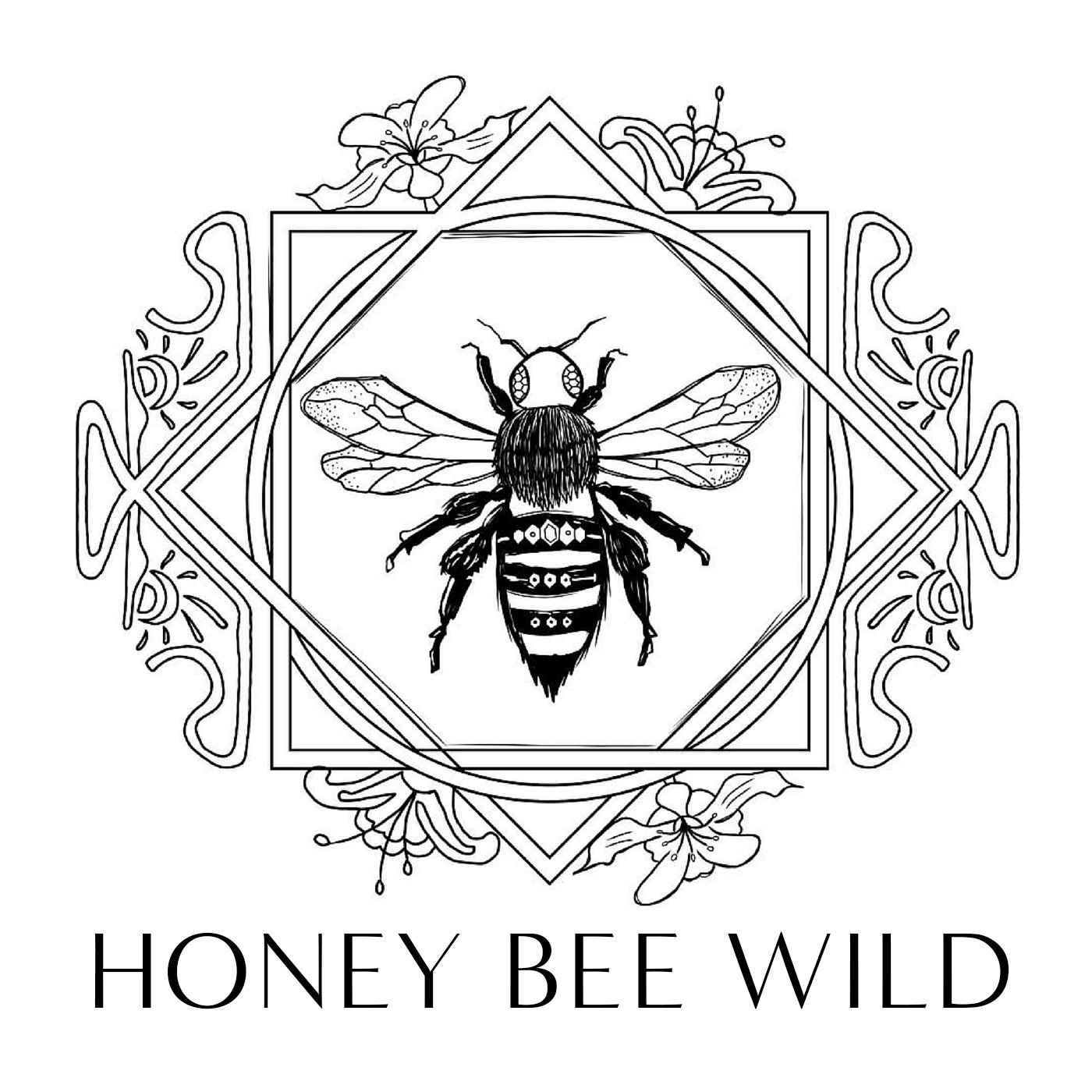


















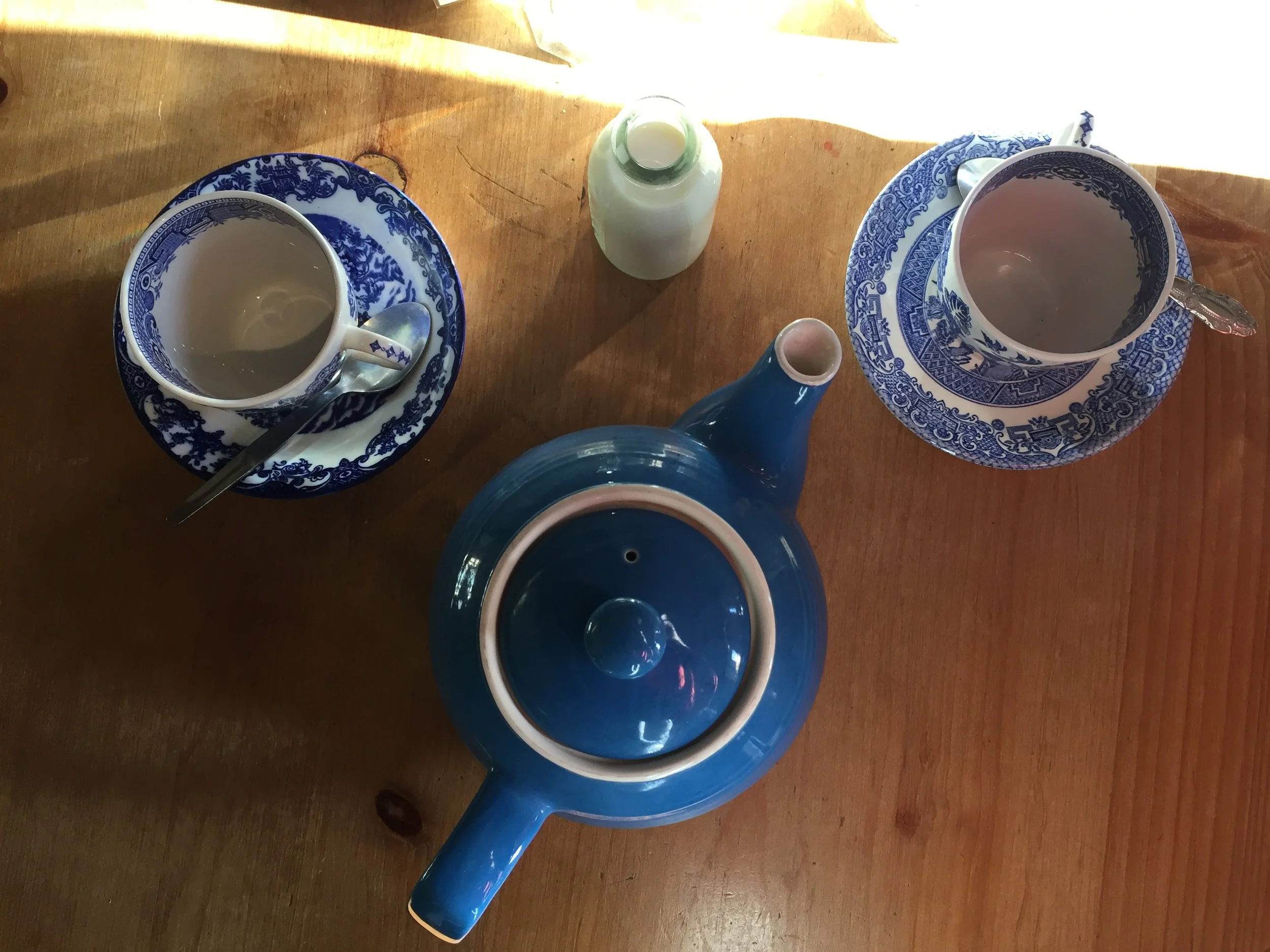

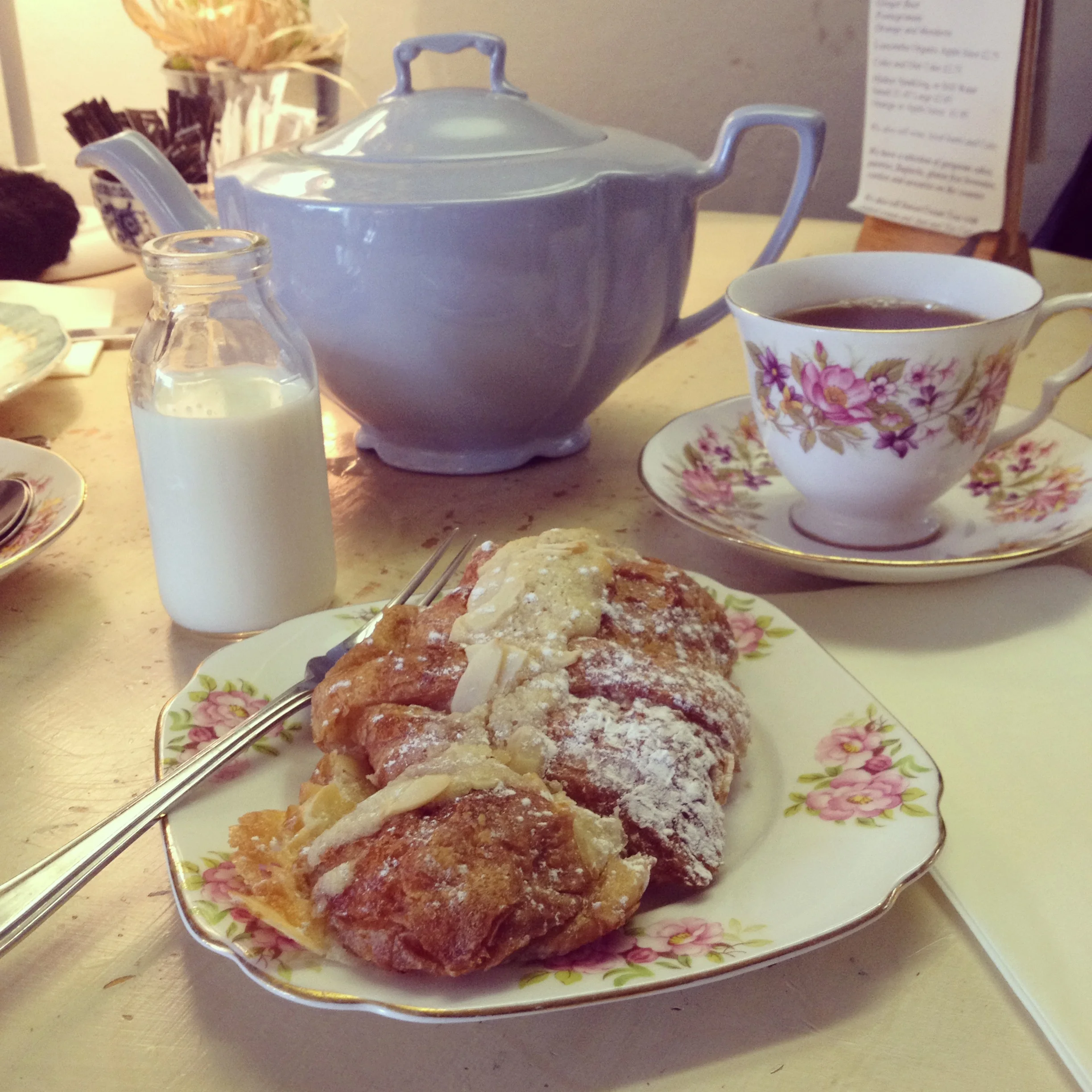





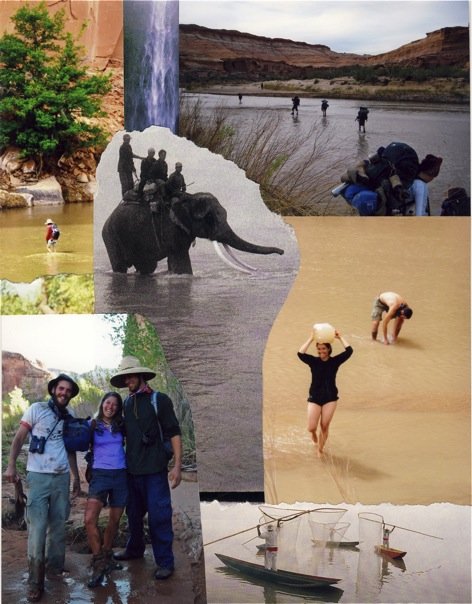
![John Collier [Public domain], via Wikimedia Commons](https://images.squarespace-cdn.com/content/v1/55f313bae4b029b54a71c646/1500593162038-1FU8NJ7WHQFS7YM2RYMU/AriellaDaly_Pythia)






















